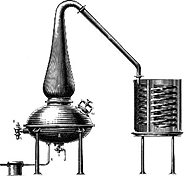Has technology in whiskey production taken anything away from American whiskey?
So much of the growth of whiskey production in this country has been wrapped up in innovation and technology. Whiskey production, early in our nation’s history, was limited by how much your local distiller could make in his/her still. A distiller was limited by how far they could move product. Roads weren’t great, and rivers only flowed one way. Once steam boats were invented in the late 1700’s and started being commonly used to navigate rivers in the 1800’s, whiskey had a new way to get to customers. River traffic created a need for canal systems. The 1820’s brought the locomotive and the Industrial Revolution. The 1830’s saw the invention of the Coffey still and now bulk whiskey could be made faster and more cheaply. American ingenuity was pushing the country and whiskey forward.
In the early 1830-40’s, James Crow was working with new methods like litmus paper testing, using a saccharimeter to test sugar levels and employing the sour mash technique to create consistency between batches. The mashing process was improved in 1869 when coiled metal heating and cooling tubes began being used to regulate temperature more easily, thus helping maintain yeast viability. Steam heat helped to extend the distilling season beyond what the weather dictated. Fredrick Stitzel, in 1879, patented storage racks that allowed for easy movement of barrels and air movement around the individual barrels. Technology, it seemed, was changing whiskey production and its innovations were being praised at World’s Fairs and expositions.
My point is that whiskey is an ever evolving spirit. As technology evolves and the industry embraces new ways to improve or simplify the process, America will be willing to adapt. Old distillers will tell you that it was better before computers were involved in the process. There is merit to the idea that if a human is the one drinking it, then a human should be the one to have their hands in the mash and their tastebuds should determine when cuts should be made. On the other hand, new technology allows a consistency of product. That consistency allows large distilleries to pump out a thousand barrels a day and we can all rest easy that the small batch bottling we buy today will be the same six months from now. Is that a bad thing?
As an artist, I have to appreciate the small distiller that is doing everything the “old fashioned way.” They have a product that they create with their own hands and can have full control over their product from grain to glass. But have you been to a microdistillery? Gadgets, meters, digital readers, and all manner of technology are at their disposal. Embracing technology doesn’t mean that you’re not “keeping it old school.” It just means that you’re using all the tools that America has made available to the American modern distiller. Cheers to that!

